DEAFNESS IN DISGUISE
Concealed Hearing Devices of the 20th Century
The
influence of Hollywood was at its apex in the 1950s and advertising
emphasized glamour and style. Celebrities were used to tout the uses of hearing
aids and many models of hearing aids reflect the Hollywood theme such as "Hollywood
Veri-Small" and "Starlet." Advertisers' claims were limitless.
"You look younger-you feel younger…helps erase that frown which
comes from concentrating…permits a relaxed posture-ends that forward
thrust of the head, that tendency to sit on the edge of your chair…makes
school marks better, your job safer, your domestic life happier, your children
better behaved."
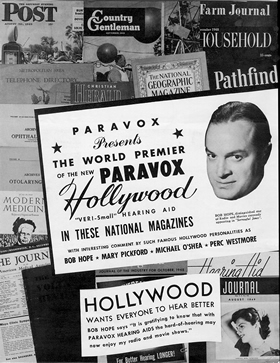 © CID - St. Louis
© CID - St. Louis
 © Courtesy of Sonotone
© Courtesy of Sonotone
 © Courtesy of Radioear (In business since 1924)
© Courtesy of Radioear (In business since 1924)
The
development of the transistor enabled once-cumbersome hearing aids
to be streamlined into single units practical for everyday use. What could
be more practical than incorporating a hearing aid-or two-into eyeglasses?
The first eyeglass model was introduced in the United States in 1953. By 1959,
they accounted for approximately 50% of the market.
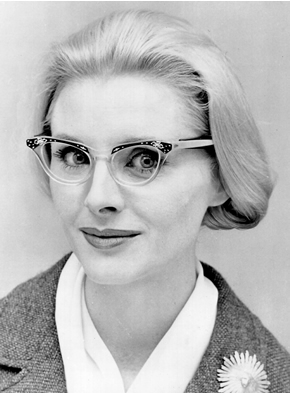 © Courtesy of Beltone Electronics Corporation
© Courtesy of Beltone Electronics Corporation
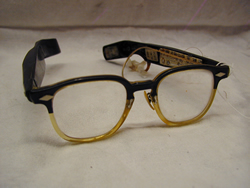 © CID - St. Louis
© CID - St. Louis
In
1953, the hearing aid was the first commercially made product to
employ the transistor. The transistor radio was not available to the public
until 1954.
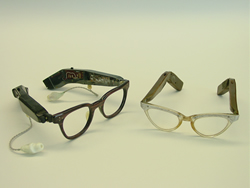 © Bernard Becker Medical Library
© Bernard Becker Medical Library
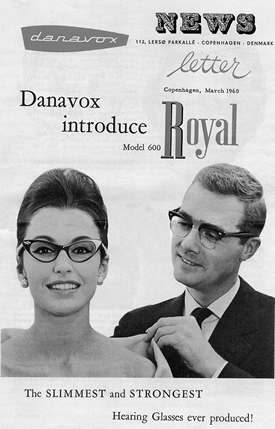 © Reprinted with permission from Arnoud Beem.
© Reprinted with permission from Arnoud Beem.
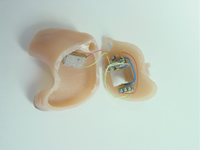 © Bernard Becker Medical Library
© Bernard Becker Medical Library
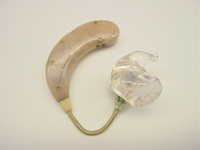 © Bernard Becker Medical Library
© Bernard Becker Medical Library
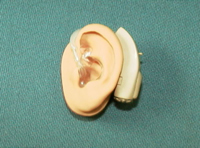 © Eriksholm Collection-Oticon A/S
© Eriksholm Collection-Oticon A/S
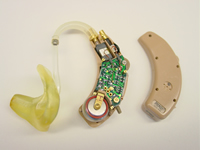 © Bernard Becker Medical Library
© Bernard Becker Medical Library
 ©
Eriksholm Collection-Oticon A/S
©
Eriksholm Collection-Oticon A/S
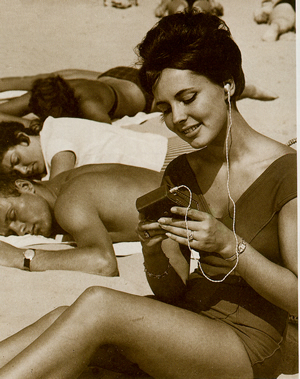 © Reprinted with permission from Arnoud Beem
© Reprinted with permission from Arnoud Beem
 © Courtesy of Eriksholm Collection Oticon A/S
© Courtesy of Eriksholm Collection Oticon A/S
The
behind-the-ear hearing aid (BTE), first introduced in the late
1950s, was an ideal means of concealing a hearing aid-it was worn discreetly
behind the ear and underneath the hair, with a custom made earmold. The BTE
incorporated all components of a hearing aid into a single, streamlined unit
including the batteries. Within a few years of the introduction of the BTE,
the BTE overtook the eyeglass hearing aid model in hearing aid sales in the
United States.
In-the-ear
hearing aids (ITE) were introduced in the 1960s and even smaller
completely-in-the-canal (ITC) hearing aids entered the market in the early
1980s. These models provided more opportunity for concealment with acoustic
benefit for many users.
Radio Hearing Aid
One ingenious design of a camouflaged hearing aid that was possible with
the development of the transistor was a radio. As seen here in the photo,
a hearing aid is disguised as an ordinary radio.
BTE
Examples of behind-the-ear hearing aids.
ITE
Examples of in-the-ear hearing aids.

 © CID - St. Louis
© CID - St. Louis © Courtesy of Radioear (In business since 1924)
© Courtesy of Radioear (In business since 1924)![]() ©
Eriksholm Collection-Oticon A/S
©
Eriksholm Collection-Oticon A/S![]() © Courtesy of Eriksholm Collection Oticon A/S
© Courtesy of Eriksholm Collection Oticon A/S